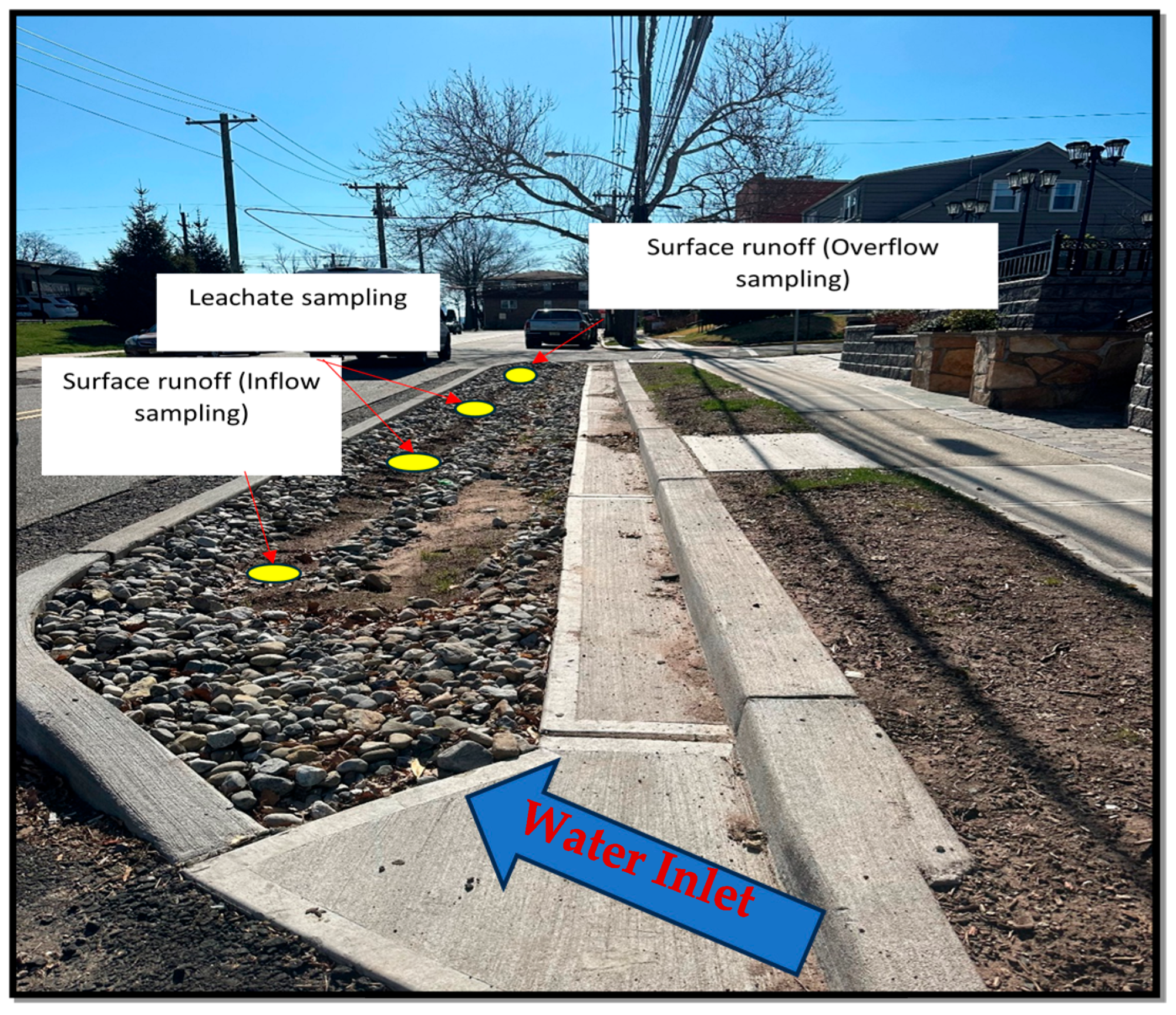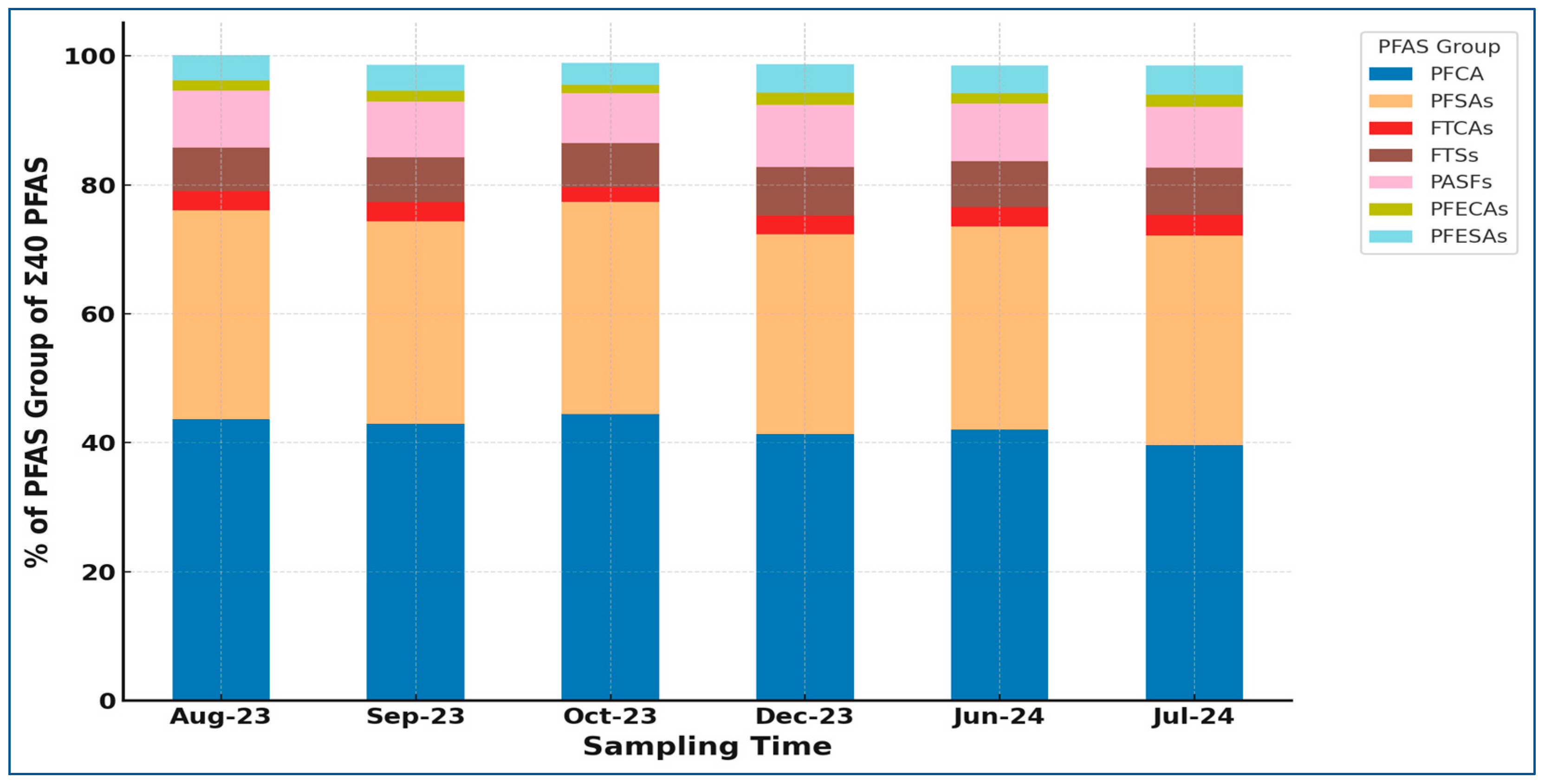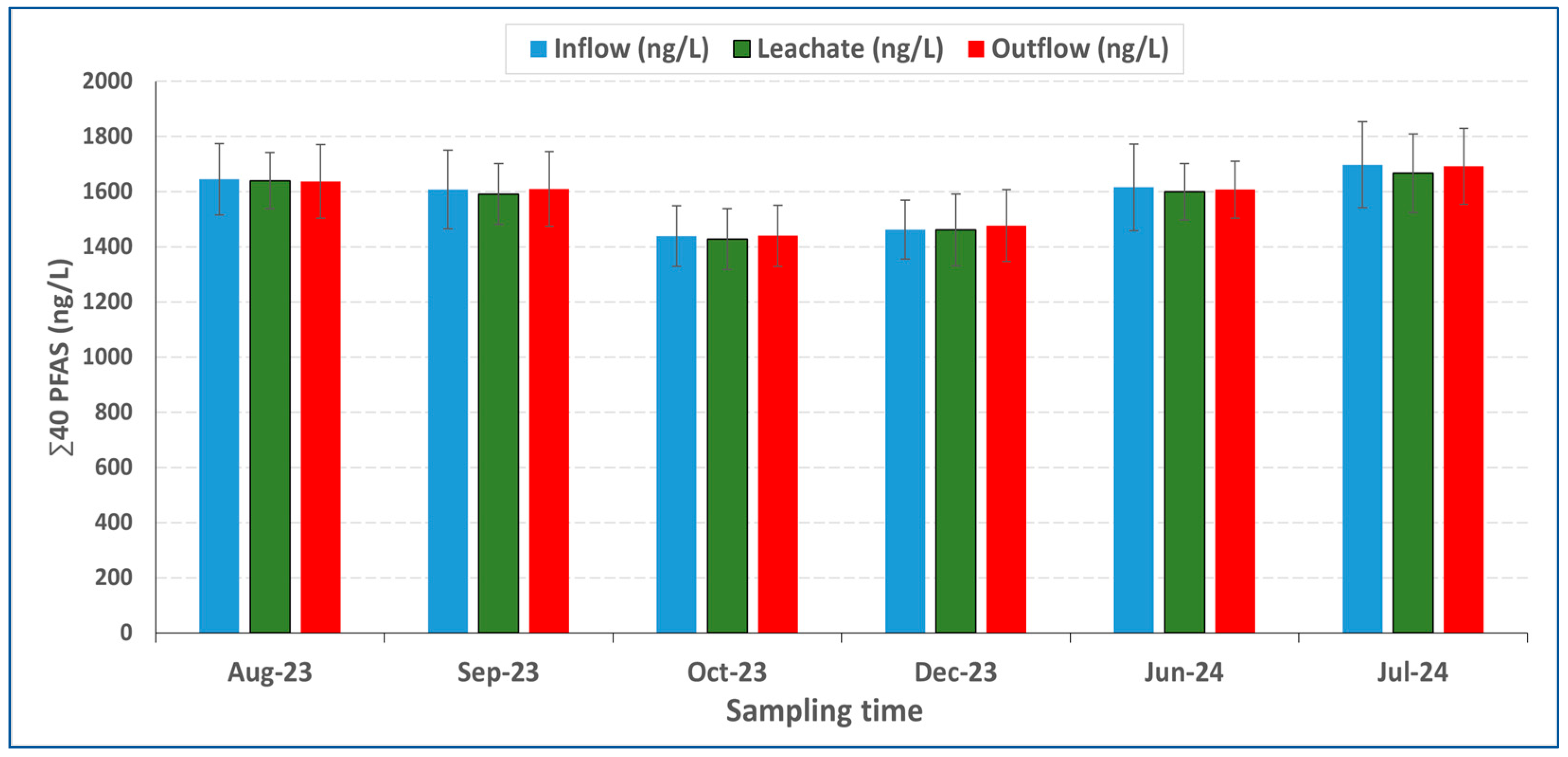Per- and Polyfluoroalkyl Substances (PFAS) in Urban Stormwater Runoff: Insights from a Roadside Rain Garden
Abstract
1. Introduction
2. Materials and Methods
2.1. Chemicals and Reagents
2.2. Site Description and Stormwater Sample Collection
2.3. Extraction Procedures and Instrumental Methods for PFAS Analysis
2.4. Quality Assurance and Quality Control
3. Results and Discussion
3.1. PFAS Distribution and Dominant Species in Stormwater Runoff
3.2. PFAS Class Distribution in Stormwater Runoff
3.3. Assessment of PFAS Concentration Change Across a Rain Garden
3.4. Potential Sources of PFAS in Stormwater Runoff
4. Conclusions
5. Recommendations
- Enhanced treatment media: Incorporate engineered amendments such as activated carbon, ion-exchange resins, or engineered mulch into rain garden designs to improve PFAS retention.
- Monitoring integration: Include PFAS monitoring in stormwater quality assessment frameworks to better capture the contribution of diffuse urban sources.
- Source control strategies: Reduce PFAS inputs at the source by targeting traffic-related materials, building products, and waste streams that act as primary contributors in impervious catchments.
- Policy development: Update urban water management guidelines to explicitly address PFAS, including setting concentration benchmarks for stormwater reuse and discharge.
- Future research: Evaluate the long-term performance of modified green infrastructure systems, including seasonal variability, leaching behavior, and combined treatment approaches, to determine sustainable PFAS mitigation strategies.
Supplementary Materials
Author Contributions
Funding
Data Availability Statement
Acknowledgments
Conflicts of Interest
References
- Sharma, R.; Malaviya, P. Management of stormwater pollution using green infrastructure: The role of rain gardens. Wiley Interdiscip. Rev. Water 2021, 8, e1507. [Google Scholar] [CrossRef]
- Fan, G.; Lin, R.; Wei, Z.; Xiao, Y.; Shangguan, H.; Song, Y. Effects of low impact development on the stormwater runoff and pollution control. Sci. Total Environ. 2022, 805, 150404. [Google Scholar] [CrossRef]
- Gao, Z.; Zhang, Q.; Li, J.; Wang, Y.; Dzakpasu, M.; Wang, X.C. First flush stormwater pollution in urban catchments: A review of its characterization and quantification towards optimization of control measures. J. Environ. Manag. 2023, 340, 117976. [Google Scholar] [CrossRef]
- Beryani, A.; Furén, R.; Österlund, H.; Tirpak, A.; Smith, J.; Dorsey, J.; Blecken, G.T. Occurrence, concentration, and distribution of 35 PFASs and their precursors retained in 20 stormwater biofilters. Environ. Sci. Technol. 2024, in press. [Google Scholar] [CrossRef]
- Williams, A.J.; Gaines, L.G.; Grulke, C.M.; Lowe, C.N.; Sinclair, G.F.; Samano, V.; Richard, A.M. Assembly and curation of lists of per- and polyfluoroalkyl substances (PFAS) to support environmental science research. Front. Environ. Sci. 2022, 10, 209. [Google Scholar] [CrossRef]
- Strynar, M.; McCord, J.; Newton, S.; Washington, J.; Barzen-Hanson, K.; Trier, X.; Munoz, G. Practical application guide for the discovery of novel PFAS in environmental samples using high resolution mass spectrometry. J. Expo. Sci. Environ. Epidemiol. 2023, 33, 575–588. [Google Scholar] [CrossRef]
- Buck, R.C.; Korzeniowski, S.H.; Laganis, E.; Adamsky, F. Identification and classification of commercially relevant per- and polyfluoroalkyl substances (PFAS). Integr. Environ. Assess. Manag. 2021, 17, 1045–1055. [Google Scholar] [CrossRef]
- Mohseni, M.; Lahiri, S.K.; Nadaraja, A.V.; Sundararaj, U.; Golovin, K. Durable and comfortable superoleophobic fabrics utilizing ultra-short-chain fluorinated surface chemistry. Chem. Eng. J. 2023, 471, 144726. [Google Scholar] [CrossRef]
- Goukeh, M.N.; Alamdari, N. Removal of contaminants in stormwater via subsurface-flow wetlands: A review with focus on nutrients, heavy metals, and PFAS. J. Environ. Eng. 2024, 150, 03124001. [Google Scholar] [CrossRef]
- Bodus, B.; O’Malley, K.; Dieter, G.; Gunawardana, C.; McDonald, W. Review of emerging contaminants in green stormwater infrastructure: Antibiotic resistance genes, microplastics, tire wear particles, PFAS, and temperature. Sci. Total Environ. 2023, 872, 167195. [Google Scholar] [CrossRef]
- Xiao, F.; Halbach, T.R.; Simcik, M.F.; Gulliver, J.S. Input characterization of perfluoroalkyl substances in wastewater treatment plants: Source discrimination by exploratory data analysis. Water Res. 2012, 46, 3101–3109. [Google Scholar] [CrossRef]
- Kim, S.K.; Kannan, K. Perfluorinated acids in air, rain, snow, surface runoff, and lakes: Relative importance of pathways to contamination of urban lakes. Environ. Sci. Technol. 2007, 41, 8328–8334. [Google Scholar] [CrossRef]
- Spahr, S.; Teixidó, M.; Sedlak, D.L.; Luthy, R.G. Hydrophilic trace organic contaminants in urban stormwater: Occurrence, toxicological relevance, and the need to enhance green stormwater infrastructure. Environ. Sci. Water Res. Technol. 2020, 6, 15–44. [Google Scholar] [CrossRef]
- Ahmadireskety, A.; Da Silva, B.F.; Robey, N.M.; Douglas, T.E.; Aufmuth, J.; Solo-Gabriele, H.M.; Bowden, J.A. Per- and polyfluoroalkyl substances (PFAS) in street sweepings. Environ. Sci. Technol. 2021, 56, 6069–6077. [Google Scholar] [CrossRef] [PubMed]
- Novak, P.A.; Hoeksema, S.D.; Thompson, S.N.; Trayler, K.M. Per- and polyfluoroalkyl substances (PFAS) contamination in a microtidal urban estuary: Sources and sinks. Mar. Pollut. Bull. 2023, 193, 115215. [Google Scholar] [CrossRef]
- Dias, D.; Bons, J.; Kumar, A.; Kabir, M.H.; Liang, H. Forever chemicals, per- and polyfluoroalkyl substances (PFAS), in lubrication. Lubricants 2024, 12, 114. [Google Scholar] [CrossRef]
- Codling, G.; Yuan, H.; Jones, P.D.; Giesy, J.P.; Hecker, M. Metals and PFAS in stormwater and surface runoff in a semi-arid Canadian city subject to large variations in temperature among seasons. Environ. Sci. Pollut. Res. 2020, 27, 18232–18241. [Google Scholar] [CrossRef]
- Zushi, Y.; Takeda, T.; Masunaga, S. Existence of nonpoint source of perfluorinated compounds and their loads in the Tsurumi River basin, Japan. Chemosphere 2008, 71, 1566–1573. [Google Scholar] [CrossRef]
- Xiao, F.; Simcik, M.F.; Gulliver, J.S. Perfluoroalkyl acids in urban stormwater runoff: Influence of land use. Water Res. 2012, 46, 6601–6608. [Google Scholar] [CrossRef]
- Abunada, Z.; Alazaiza, M.Y.; Bashir, M.J. An overview of per- and polyfluoroalkyl substances (PFAS) in the environment: Source, fate, risk and regulations. Water 2020, 12, 3590. [Google Scholar] [CrossRef]
- McGuire, M.P.; Grimley, D.A.; Phillips, A.C.; Stillwell, A.S.; William, R.; Shen, J.; Schneemann, M. Retrofitting urban land through integrative, subsoils-based planning of green stormwater infrastructure: A research framework. Environ. Res. Infrastruct. Sustain. 2021, 1, 035003. [Google Scholar] [CrossRef]
- Rivera, D.Z.; Hendricks, M.D. Municipal undergreening: Framing the planning challenges of implementing green infrastructure in marginalized communities. Plan. Theory Pract. 2022, 23, 807–811. [Google Scholar] [CrossRef]
- Wang, M.; Sun, C.; Zhang, D. Opportunities and challenges in green stormwater infrastructure (GSI): A comprehensive and bibliometric review of ecosystem services from 2000 to 2021. Environ. Res. 2023, 225, 116701. [Google Scholar] [CrossRef]
- Ortiz, E.; Mayr Mejia, A.; Borely, E.; Schauer, L.; Young Green, L.; Trotz, M. Can reuse of stormwater detention pond water meet community urban agriculture needs? Sustainability 2025, 17, 523. [Google Scholar] [CrossRef]
- Raimondi, A.; Quinn, R.; Abhijith, G.R.; Becciu, G.; Ostfeld, A. Rainwater harvesting and treatment: State of the art and perspectives. Water 2023, 15, 1518. [Google Scholar] [CrossRef]
- Vigneswaran, S.; Kandasamy, J.; Ratnaweera, H. High rate stormwater treatment for water reuse and conservation. Appl. Sci. 2025, 15, 590. [Google Scholar] [CrossRef]
- U.S. Environmental Protection Agency. Draft Method 1633: Analysis of Per- and Polyfluoroalkyl Substances (PFAS) in Aqueous, Solid, Biosolids, and Tissue Samples by LC-MS/MS (4th Draft); EPA 821-D-21-001; U.S. Environmental Protection Agency: Washington, DC, USA, 2023.
- New Jersey Weather and Climate Network. Station Summary: Secaucus. Rutgers University. 2025. Available online: https://www.njweather.org/station/9 (accessed on 15 January 2025).
- Page, D.; Vanderzalm, J.; Kumar, A.; Cheng, K.Y.; Kaksonen, A.H.; Simpson, S. Risks of perfluoroalkyl and polyfluoroalkyl substances (PFAS) for sustainable water recycling via aquifers. Water 2019, 11, 1737. [Google Scholar] [CrossRef]
- Ismail, U.M.; Elnakar, H.; Khan, M.F. Sources, fate, and detection of dust-associated perfluoroalkyl and polyfluoroalkyl substances (PFAS): A review. Toxics 2023, 11, 335. [Google Scholar] [CrossRef]
- Savvaides, T.; Koelmel, J.P.; Zhou, Y.; Lin, E.Z.; Stelben, P.; Aristizabal-Henao, J.J.; Bowden, J.A.; Godri Pollitt, K.J. Prevalence and implications of per- and polyfluoroalkyl substances (PFAS) in settled dust. Curr. Environ. Health Rep. 2021, 8, 323–335. [Google Scholar] [CrossRef]
- Kozik, S. Tracking Perfluoroalkyl Substances from Wastewater Influent to Its Accumulation in Vegetables and Forage Grass. Master’s Thesis, Utah State University, Logan, UT, USA, 2024. [Google Scholar]
- Zhang, K.; Qadeer, A.; Chang, S.; Tu, X.; Shang, H.; Khan, M.A.; Feng, Y. Short-chain PFASs dominance and their environmental transport dynamics in urban water systems: Insights from multimedia transport analysis and human exposure risk. Environ. Int. 2025, 202, 109602. [Google Scholar] [CrossRef]
- Wang, Z.; Cousins, I.T.; Scheringer, M.; Hungerbühler, K. Fluorinated alternatives to long-chain perfluoroalkyl carboxylic acids (PFCAs), perfluoroalkane sulfonic acids (PFSAs) and their potential precursors. Environ. Int. 2013, 60, 242–248. [Google Scholar] [CrossRef]
- Kali, S.E.; Österlund, H.; Viklander, M.; Blecken, G. Occurrence, concentration and distribution of 50 organic contaminants in water and bottom sediment from urban streams affected by stormwater discharges. Water Res. 2025, 283, 123847. [Google Scholar] [CrossRef]
- Bossi, R.; Ellermann, T.; Skov, H. Per- and Polyfluoroalkyl Substances (PFAS) in Atmosphere and Deposition. In Scientific Report from DCE—Danish Centre for Environment and Energy; Aarhus University: Aarhus, Denmark, 2023; No. 20; Available online: https://dce.au.dk/fileadmin/dce.au.dk/Udgivelser/Notater_2023/N2023_20.pdf (accessed on 2 May 2025).
- Goodrow, S.M.; Ruppel, B.; Lippincott, R.L.; Post, G.B.; Procopio, N.A. Investigation of levels of perfluoroalkyl substances in surface water, sediment and fish tissue in New Jersey, USA. Sci. Total Environ. 2020, 729, 138839. [Google Scholar] [CrossRef] [PubMed]
- Viticoski, R.L.; Wang, D.; Feltman, M.A.; Mulabagal, V.; Rogers, S.R.; Blersch, D.M.; Hayworth, J.S. Spatial distribution and mass transport of perfluoroalkyl substances (PFAS) in surface water: A statewide evaluation of PFAS occurrence and fate in Alabama. Sci. Total Environ. 2022, 836, 155524. [Google Scholar] [CrossRef] [PubMed]
- da Silva, B.F.; Aristizabal-Henao, J.J.; Aufmuth, J.; Awkerman, J.; Bowden, J.A. Survey of per- and polyfluoroalkyl substances (PFAS) in surface water collected in Pensacola, FL. Heliyon 2022, 8, e09932. [Google Scholar] [CrossRef] [PubMed]
- Awonaike, B.; Parajulee, A.; Lei, Y.D.; Wania, F. Traffic-related sources may dominate urban water contamination for many organic contaminants. Environ. Res. Lett. 2022, 17, 044030. [Google Scholar] [CrossRef]
- Chen, Y.; Zhang, H.; Liu, Y.; Bowden, J.A.; Tolaymat, T.M.; Townsend, T.G.; Solo-Gabriele, H.M. Evaluation of per- and polyfluoroalkyl substances (PFAS) in leachate, gas condensate, stormwater and groundwater at landfills. Chemosphere 2023, 318, 137903. [Google Scholar] [CrossRef]
- Bai, X.; Son, Y. Perfluoroalkyl substances (PFAS) in surface water and sediments from two urban watersheds in Nevada, USA. Sci. Total Environ. 2021, 751, 141622. [Google Scholar] [CrossRef]
- Olmsted, J.L.; Ahmadireskety, A.; Da Silva, B.F.; Robey, N.; Aristizabal-Henao, J.J.; Bonzongo, J.C.J.; Bowden, J.A. Using regulatory classifications to assess the impact of different land use types on per- and polyfluoroalkyl substance concentrations in stormwater pond sediments. J. Environ. Eng. 2021, 147, 06021005. [Google Scholar] [CrossRef]
- Kali, S.E.; Österlund, H.; Viklander, M.; Blecken, G.T. Stormwater discharges affect PFAS occurrence, concentrations, and spatial distribution in water and bottom sediment of urban streams. Water Res. 2025, 271, 122973. [Google Scholar] [CrossRef]
- Saifur, S.; Gardner, C.M. Loading, transport, and treatment of emerging chemical and biological contaminants of concern in stormwater. Water Sci. Technol. 2021, 83, 2863–2885. [Google Scholar] [CrossRef]
- Venkataraman, H. Tire Wear Particle Characterization and PFAS Adsorption. Ph.D. Thesis, University of Texas at Austin, Austin, TX, USA, 2025. [Google Scholar]
- Pramanik, B.K.; Roychand, R.; Monira, S.; Bhuiyan, M.; Jegatheesan, V. Fate of road-dust associated microplastics and per- and polyfluorinated substances in stormwater. Process Saf. Environ. Prot. 2020, 144, 236–241. [Google Scholar] [CrossRef]
- Gasperi, J.; Le Roux, J.; Deshayes, S.; Ayrault, S.; Bordier, L.; Boudahmane, L.; Gromaire, M.C. Micropollutants in urban runoff from traffic areas: Target and non-target screening on four contrasted sites. Water 2022, 14, 30394. [Google Scholar] [CrossRef]
- Houtz, E.F.; Sedlak, D.L. Oxidative conversion as a means of detecting precursors to perfluoroalkyl acids in urban runoff. Environ. Sci. Technol. 2012, 46, 9342–9349. [Google Scholar] [CrossRef] [PubMed]
- Murakami, M.; Shinohara, H.; Takada, H. Evaluation of wastewater and street runoff as sources of perfluorinated surfactants (PFSs). Chemosphere 2009, 74, 487–493. [Google Scholar] [CrossRef] [PubMed]
- Wilkinson, J.L.; Swinden, J.; Hooda, P.S.; Barker, J.; Barton, S. Markers of anthropogenic contamination: A validated method for quantification of pharmaceuticals, illicit drug metabolites, perfluorinated compounds, and plasticisers in sewage treatment effluent and rain runoff. Chemosphere 2016, 159, 638–646. [Google Scholar] [CrossRef] [PubMed]
- Dong, H.; Lu, G.; Yan, Z.; Liu, J.; Yang, H.; Zhang, P.; Nkoom, M. Distribution, sources and human risk of perfluoroalkyl acids (PFAAs) in a receiving riverine environment of the Nanjing urban area, East China. J. Hazard. Mater. 2020, 381, 120911. [Google Scholar] [CrossRef]
- Udvary, J.; Regina, S.; Sabine, J.; Brigitte, H. Non-metal roofing materials as potential sources of pollutants-laboratory leaching studies on various roofing materials. J. Hazard. Mater. 2025, 491, 137972. [Google Scholar] [CrossRef]
- Eichler, C. Characterization of the Distribution and Fate of Neutral Per-and Polyfluoroalkyl Substances (PFAS) in Indoor Environments Including the Role of Clothing. Ph.D. Thesis, The University of North Carolina at Chapel Hill, Chapel Hill, NC, USA, 2024. [Google Scholar] [CrossRef]
- McGarr, J.; Eric, G.D.; Mohamad, S. Fate and transport of per-and polyfluoroalkyl substances (PFAS) at aqueous film forming foam (AFFF) discharge sites: A review. Soil Syst. 2023, 7, 53. [Google Scholar] [CrossRef]




Disclaimer/Publisher’s Note: The statements, opinions and data contained in all publications are solely those of the individual author(s) and contributor(s) and not of MDPI and/or the editor(s). MDPI and/or the editor(s) disclaim responsibility for any injury to people or property resulting from any ideas, methods, instructions or products referred to in the content. |
© 2025 by the authors. Licensee MDPI, Basel, Switzerland. This article is an open access article distributed under the terms and conditions of the Creative Commons Attribution (CC BY) license (https://creativecommons.org/licenses/by/4.0/).
Share and Cite
Saleh, H.; Sarkar, D.; Zhang, Z.; Boufadel, M.; Datta, R. Per- and Polyfluoroalkyl Substances (PFAS) in Urban Stormwater Runoff: Insights from a Roadside Rain Garden. Water 2025, 17, 2982. https://doi.org/10.3390/w17202982
Saleh H, Sarkar D, Zhang Z, Boufadel M, Datta R. Per- and Polyfluoroalkyl Substances (PFAS) in Urban Stormwater Runoff: Insights from a Roadside Rain Garden. Water. 2025; 17(20):2982. https://doi.org/10.3390/w17202982
Chicago/Turabian StyleSaleh, Hadeer, Dibyendu Sarkar, Zhiming Zhang, Michel Boufadel, and Rupali Datta. 2025. "Per- and Polyfluoroalkyl Substances (PFAS) in Urban Stormwater Runoff: Insights from a Roadside Rain Garden" Water 17, no. 20: 2982. https://doi.org/10.3390/w17202982
APA StyleSaleh, H., Sarkar, D., Zhang, Z., Boufadel, M., & Datta, R. (2025). Per- and Polyfluoroalkyl Substances (PFAS) in Urban Stormwater Runoff: Insights from a Roadside Rain Garden. Water, 17(20), 2982. https://doi.org/10.3390/w17202982










